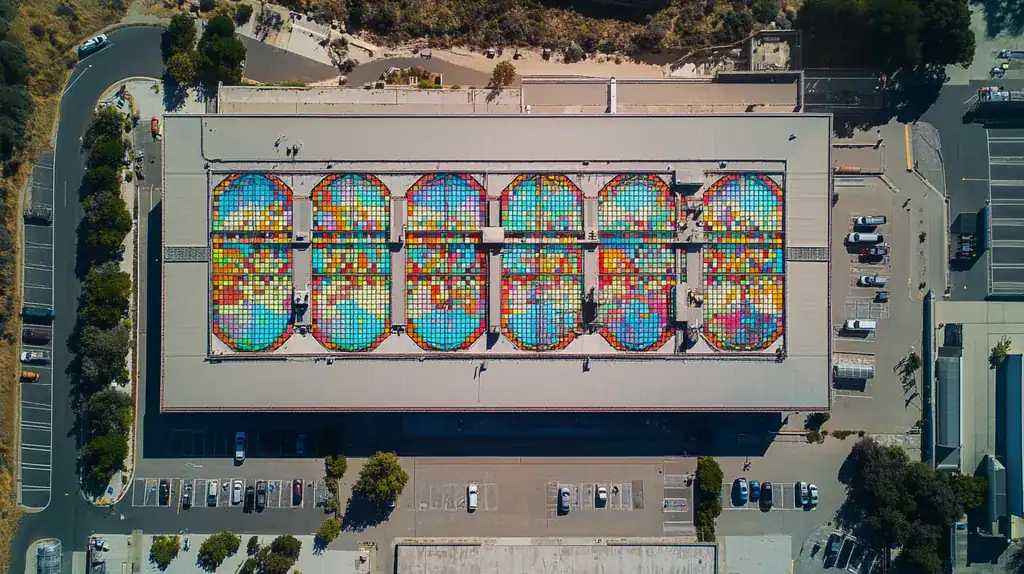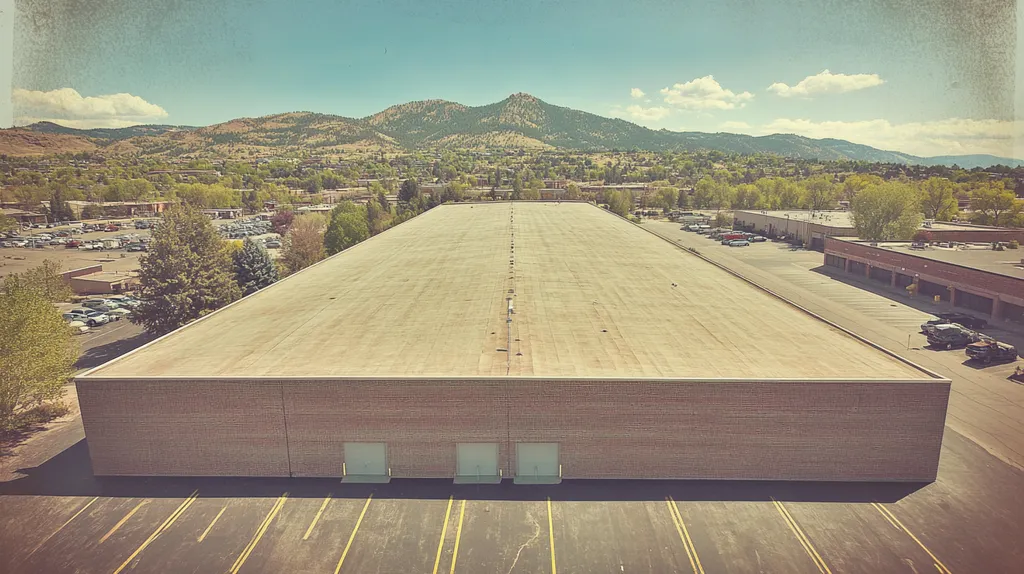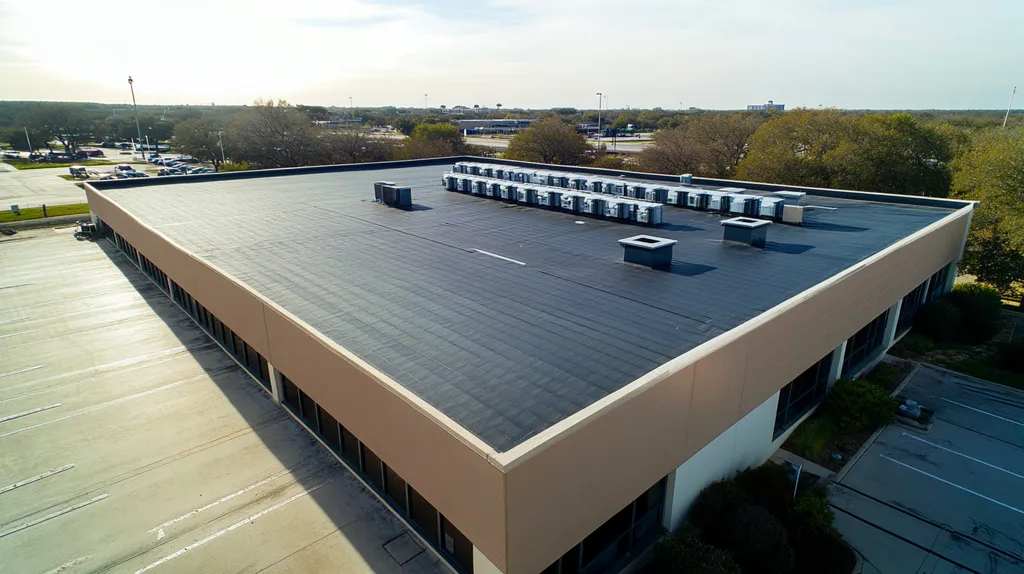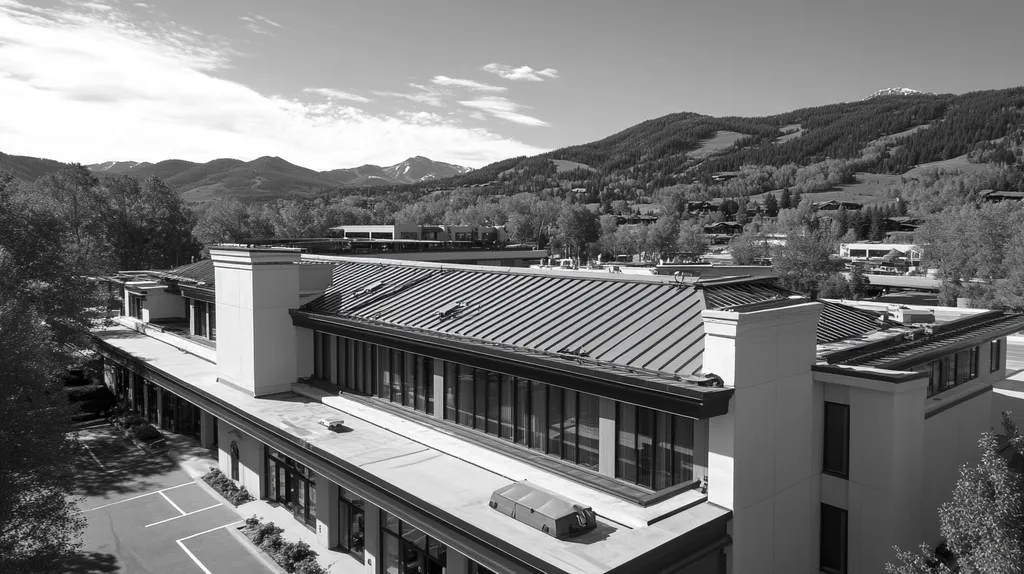Commercial rooftop equipment installations affect over 5 billion square feet of building space nationwide, yet widespread misconceptions about their impact cost property owners millions in preventable damage annually.
From HVAC systems to solar installations, each piece of equipment creates unique stresses that can reduce roof lifespan by up to 70% when improperly managed.
This comprehensive analysis separates common myths from documented realities, providing property owners and facility managers with evidence-based strategies to protect their roofing investments while maximizing equipment functionality.
SECTION 1: COMMON MISCONCEPTIONS
Every day, commercial building owners make costly decisions based on misconceptions about rooftop equipment and roof longevity. These misunderstandings can lead to premature roof failure, unnecessary repairs, and substantial financial impacts. Three prevalent myths continue to plague the industry: that equipment-free roofs require minimal attention, that all rooftop installations affect roofs similarly, and that modern design solutions can completely eliminate equipment-related issues. Addressing these misconceptions is crucial for protecting roof investments and ensuring optimal building performance.
No Equipment Means No Wear and Tear
Building owners frequently assume that roofs without equipment remain pristine and maintenance-free. This dangerous oversimplification ignores fundamental environmental stressors that affect all roofs, regardless of equipment presence.
Even equipment-free roofs face constant bombardment from UV radiation, thermal cycling, and moisture penetration. These natural forces steadily degrade roofing materials and compromise structural integrity over time.
The absence of equipment can actually mask developing problems by reducing regular roof inspections. Without routine maintenance checks that typically accompany equipment servicing, issues often go undetected until significant damage occurs.
Empty roof areas still require proper drainage systems, expansion joints, and other critical components that need regular inspection and maintenance. Neglecting these elements based on the absence of equipment accelerates deterioration.
All Rooftop Gear Has Equal Impact
The design and purpose of rooftop equipment significantly influences its impact on roof longevity. HVAC systems, ventilation units, and foot traffic each affect roofs differently, requiring specialized attention and maintenance approaches. (source: Grizzly Roofing)
Heavy mechanical units create concentrated load points that can compress insulation and create low spots where water pools. These areas become particularly vulnerable to leaks and material breakdown.
Vibrating equipment generates constant micro-movements that stress nearby seams and flashings. Over time, these vibrations can loosen fasteners and create gaps in waterproofing systems.
Lightweight equipment like satellite dishes or solar panels may seem innocuous but can still compromise roof integrity through penetrations and added wind loads. Each installation requires specific preventive measures based on its unique characteristics.
Roof Design Neutralizes Equipment Effects
Modern roofing systems incorporate impressive engineering advances, but no design completely eliminates equipment-related stress. Even the most sophisticated solutions require ongoing maintenance and monitoring.
While structural reinforcement helps distribute equipment loads, connection points remain vulnerable. Penetrations through the roof membrane create potential water entry paths that must be regularly inspected and maintained.
Changes in building use or equipment upgrades can overwhelm original design parameters. What works initially may prove insufficient as operational needs evolve.
Environmental factors like extreme weather events, temperature fluctuations, and settling can compromise even well-designed equipment installations. Regular assessment ensures design features continue functioning as intended.
The most effective approach combines smart design with proactive maintenance rather than relying solely on initial engineering. This strategy helps identify and address issues before they escalate into major problems.
SECTION 2: PRACTICAL IMPLICATIONS
Every commercial rooftop tells a story of equipment interaction, where seemingly minor oversights can escalate into major structural issues. Studies indicate that improper equipment installation and maintenance contribute to over 60% of premature roof failures. Understanding these practical implications isn’t just about preventing damage – it’s about protecting a substantial capital investment that directly impacts building operations and maintenance budgets.
Equipment Weight and Load Distribution
Industrial roofing systems, while engineered for durability and typically warranted for 20 years, face significant challenges from equipment weight distribution. Regular assessment and maintenance are crucial for achieving or exceeding expected lifespans. (source: Facility Executive)
Static loads from HVAC units and other mechanical equipment create pressure points that compress roofing materials and insulation. These compression zones become natural collection points for standing water, accelerating material degradation.
Dynamic loads from equipment vibration compound the issue by causing micro-movements in supporting structures. These subtle shifts can create gaps in flashing and compromise waterproof barriers over time.
Load distribution plates and reinforced mounting points help mitigate these pressures, but require regular inspection to ensure continued effectiveness. Even minor settling or shifting can dramatically alter load patterns and create new stress points.
HVAC and Foot Traffic Damage Potential
Service technicians accessing HVAC equipment create concentrated patterns of wear that can quickly compromise roofing materials. Each maintenance visit risks punctures, scrapes, and compression damage to protective membranes.
Equipment vibration generates continuous stress on mounting points and surrounding materials. These forces gradually weaken seals and create pathways for moisture infiltration.
Seasonal maintenance activities often coincide with extreme weather conditions, multiplying the potential for damage. Hot surfaces become more susceptible to punctures, while cold temperatures make materials brittle and prone to cracking.
The combination of foot traffic and equipment servicing necessitates designated walkways and equipment-specific maintenance protocols. These protective measures must evolve with changing weather patterns and equipment usage.
Penetrations and Seam Stress Explained
Every rooftop penetration creates a potential failure point where water can bypass waterproofing systems. These vulnerabilities multiply with each new piece of equipment installed, from electrical conduits to ventilation stacks.
Thermal cycling causes repeated expansion and contraction of roofing materials around penetrations. This constant movement stresses seals and can create gaps between flashing and roof surfaces.
Wind uplift forces affect penetrations differently than flat roof surfaces, creating additional stress points. These forces can gradually loosen fasteners and compromise weathertight seals.
Water infiltration through compromised penetrations often travels significant distances before appearing inside the building. This delayed detection allows hidden damage to develop, potentially affecting structural components.
SECTION 3: COST OF MISINFORMATION
The financial impact of rooftop equipment misconceptions extends far beyond routine maintenance costs. Industry data reveals that mismanaged rooftop systems can slash a roof’s expected lifespan by up to 40%, forcing premature replacements that often exceed $500,000 for large commercial facilities. Understanding these costs is crucial for property owners and facility managers who must balance immediate operational needs with long-term asset protection.
Shortened Roof Lifespan and Replacement Costs
Regular maintenance and appropriate equipment handling significantly impact commercial roof longevity. Industrial roofing systems typically carry 20-year warranties but can last considerably longer with proper care and attention to equipment interactions. (source: Facility Executive)
When equipment maintenance lapses, accelerated degradation often follows. Leaked coolant from HVAC units can break down roofing materials, while improperly secured equipment can create punctures and tears that compromise the entire system.
The financial burden of early replacement extends beyond material and labor costs. Building owners face disrupted operations, temporary relocation expenses, and potential damage to sensitive equipment or inventory below.
Most concerning is the compounding effect of deferred maintenance. Small issues quickly escalate into major problems, forcing owners to replace roofs years before their expected end-of-life date.
Emergency Repairs and Unplanned Downtime
Emergency roofing repairs typically cost 3-5 times more than scheduled maintenance work. These urgent interventions often require overtime labor, expedited materials, and specialized equipment mobilization.
Water infiltration from compromised equipment mounting points can damage electrical systems, inventory, and interior finishes. A single major leak event can result in hundreds of thousands in collateral damage.
Business interruption costs frequently exceed direct repair expenses. Manufacturing facilities face production losses, while retail spaces risk inventory damage and lost sales during repairs.
The ripple effect impacts tenant satisfaction and lease renewal rates. Commercial tenants experiencing repeated disruptions due to roof issues often seek alternative locations, creating additional revenue loss for property owners.
Insurance Premiums and Warranty Claims
Insurance carriers increasingly scrutinize rooftop equipment maintenance records when setting premium rates. Properties with documented equipment-related roof damage face higher premiums and deductibles.
Warranty claims often face rejection when investigation reveals equipment-related negligence. Many manufacturers explicitly exclude damage caused by improperly maintained or installed rooftop equipment.
The complexity of multiple warranty coverages – roof system, equipment, and installation – creates coverage gaps. Building owners frequently discover these gaps only after significant damage has occurred.
Risk management strategies must account for both direct maintenance costs and potential warranty implications. Proper documentation of equipment maintenance becomes crucial for protecting warranty coverage and managing insurance costs.
SECTION 4: REALITY CHECK
Commercial rooftop equipment installations represent a critical intersection of functionality and structural integrity. Studies indicate that 85% of premature roof failures involve equipment-related issues, from improper installation to inadequate maintenance protocols. Understanding these dynamics isn’t just about preventing failure – it’s about protecting substantial investments and ensuring operational continuity. Modern commercial buildings face increasing pressure to maximize rooftop space while maintaining structural integrity.
How Rooftop Installations Truly Affect Performance
Rooftop equipment creates concentrated stress points that can compromise even the most robust roofing systems. These pressure zones become natural collection points for water, accelerating material breakdown and creating potential leak pathways.
Mechanical vibrations from operating equipment generate continuous micro-movements throughout surrounding roof areas. These subtle but persistent forces gradually weaken seams, loosen fasteners, and create gaps in waterproofing systems.
Equipment installations frequently interrupt natural drainage patterns, creating new water flow challenges. Blocked or redirected water flow leads to ponding, which can add thousands of pounds of unexpected weight to roof structures.
Adding an acrylic or silicone coating over existing roof systems can extend well-maintained roof lifespans by 7-10 years, even with equipment present. (source: Facility Executive)
Material versus Equipment: What Drives Failure
Modern roofing materials demonstrate remarkable resilience against environmental stressors but remain vulnerable to equipment-related damage. The interaction between materials and equipment creates unique wear patterns that accelerate degradation.
Heat exhaust from mechanical systems can raise local roof temperatures by 30-40 degrees, pushing materials beyond their design tolerances. These temperature spikes cause premature aging and brittleness in affected areas.
Chemical exposure from equipment leaks or maintenance activities can break down roofing compounds. Even minor fluid drips can initiate chemical reactions that compromise material integrity over time.
The interface between equipment mounting points and roof surfaces creates particularly vulnerable zones. These transition areas experience enhanced stress from thermal cycling, mechanical movement, and water exposure.
Best and Worst Case Equipment Scenarios
Optimal equipment installations incorporate purpose-built mounting systems that distribute loads effectively. These systems include isolation pads, proper flashing heights, and maintained drainage paths around equipment footprints.
Regular preventive maintenance programs catch minor issues before they escalate into major problems. This includes checking mounting points, ensuring proper drainage, and addressing any signs of material stress.
The worst scenarios typically involve improper installation combined with neglected maintenance. Equipment mounted directly on roof surfaces, blocked drainage paths, and ignored warning signs create compound problems.
Failed equipment scenarios often begin with seemingly minor oversights. Loose fasteners allow movement, compromised seals permit water intrusion, and blocked drains create ponding – all preventable conditions that cascade into significant failures.
SECTION 5: EVIDENCE-BASED ALTERNATIVES
Every year, commercial property owners waste millions on reactive equipment-related roof repairs that could have been prevented. Research shows that proper equipment placement and protection strategies can extend roof life by 40-60% compared to traditional approaches. The difference lies not in choosing between having equipment or not, but in implementing proven methodologies for equipment integration that preserve roof integrity while maintaining operational efficiency.
Optimal Equipment Placement Strategies
Strategic equipment positioning begins with load distribution analysis. Concentrating heavy units along load-bearing walls and structural support points reduces stress on the roofing system while maintaining operational efficiency.
Elevation requirements play a crucial role in equipment longevity. Raising units at least 14 inches above the roof surface allows proper drainage and simplifies maintenance access without compromising the roof membrane.
Traffic pattern optimization reduces wear patterns and maintenance-related damage. Creating dedicated service pathways and maintaining clear zones around equipment prevents unnecessary roof surface exposure.
Wind exposure considerations affect both equipment and roof performance. Proper spacing between units reduces turbulence while allowing sufficient maintenance access, protecting both the equipment and surrounding roof areas.
Protective Matting and Padding Solutions
Modern protection systems utilize composite materials that distribute weight while allowing moisture evacuation. These specialized surfaces prevent compression damage while maintaining the roof’s ability to shed water effectively.
Impact zones around equipment require enhanced protection beyond standard walk pads. Reinforced landing areas for maintenance activities prevent punctures and tears during routine service visits.
Chemical-resistant barriers protect roof membranes from equipment leaks and maintenance spills. These protective layers prevent costly chemical degradation of roofing materials while maintaining their flexibility and performance.
Temperature-specific solutions address both hot and cold exposure risks. Specialized padding prevents heat transfer from equipment while protecting roof materials from brittleness in cold conditions.
Scheduled Maintenance and Inspection Protocols
Comprehensive inspection programs must address both equipment and roof interface points. Monthly visual checks of critical areas, combined with quarterly detailed inspections, catch developing issues before they cause significant damage.
Documentation systems track equipment-related wear patterns over time. This data-driven approach allows facility managers to identify problematic installations and adjust maintenance schedules accordingly.
Seasonal preparation protocols protect both equipment and roof systems during extreme weather. Pre-winter and pre-summer inspections ensure protection systems remain effective under changing conditions.
Integration of equipment and roof maintenance schedules maximizes efficiency while minimizing roof traffic. Coordinated service visits reduce the frequency of roof access while ensuring all systems receive necessary attention.
SECTION 6: TEST AND VERIFY
Modern commercial roofing demands sophisticated monitoring approaches to protect substantial investments. With rooftop equipment installations becoming increasingly complex, traditional visual inspections alone miss up to 70% of developing issues. Advanced testing and verification methods now serve as critical tools for identifying problems before they escalate into costly failures, often detecting issues months before they would become visible to the naked eye.
Early Leak Detection Systems
Electronic leak detection systems have revolutionized how facility managers protect commercial roofs. These systems utilize advanced sensors to monitor moisture levels and electrical conductivity across the entire roof surface, providing real-time alerts when water breaches occur.
Grid-based monitoring systems can pinpoint leak locations within inches, dramatically reducing diagnostic time and repair costs. This precision targeting allows maintenance teams to address issues before water can spread through underlying insulation layers.
Modern detection systems integrate with building automation platforms, providing instant notifications to facility personnel. This immediate awareness helps prevent minor leaks from escalating into major structural problems.
Data logging capabilities create detailed histories of moisture events, helping identify patterns related to equipment operation or weather conditions. This historical tracking enables predictive maintenance strategies that prevent future issues.
Regular Structural Load Assessments
Regular structural load assessments ensure rooftop equipment installations remain within design parameters. These evaluations must account for both static loads from permanent equipment and dynamic loads from operational vibrations.
Professional engineering assessments should occur annually and after any significant equipment changes. These reviews examine load distribution, structural deflection, and potential stress points around equipment mounting locations.
Thermal imaging surveys reveal hidden compression damage and insulation degradation beneath equipment installations. These non-invasive inspections identify developing issues before they compromise roof integrity.
Load distribution analysis must account for seasonal variations in equipment weight and performance. Winter ice accumulation and summer thermal expansion can significantly alter how equipment affects underlying roof structures.
Roof Integrity Monitoring Technology
Advanced monitoring systems now provide continuous assessment of roof membrane performance and structural behavior. These technologies measure factors like membrane strain, displacement, and environmental conditions that affect roof longevity.
Wireless sensor networks track subtle changes in roof behavior, detecting early warning signs of potential failures. This constant surveillance helps facility managers optimize maintenance schedules and prevent unexpected repairs.
Smart monitoring platforms integrate weather data with roof performance metrics to predict potential stress points. This predictive capability allows maintenance teams to reinforce vulnerable areas before equipment-related damage occurs.
Cloud-based monitoring solutions enable remote oversight of multiple facilities, streamlining maintenance coordination and emergency response. These systems provide real-time alerts and detailed analytics that support data-driven maintenance decisions.
The Bottom Line
With over 5 billion square feet of commercial roofing affected by equipment installations nationwide, proper management of these systems represents a $12 billion annual impact on building operating costs.
Research consistently shows that implementing comprehensive equipment protocols can extend roof life by 40-60%, while poor practices reduce expected lifespan by up to 70%.
The integration of modern monitoring technology, strategic equipment placement, and scheduled maintenance programs has become essential for protecting these substantial investments.
For commercial property owners and facility managers, the choice is clear: either invest in evidence-based equipment management strategies now, or face premature roof replacement costs that often exceed $500,000 per occurrence.
The future of commercial roofing depends on bridging the gap between equipment functionality and roof preservation through systematic, data-driven approaches.
FREQUENTLY ASKED QUESTIONS
Q. Do commercial roofs really need maintenance if there’s no equipment?
A. Yes, even equipment-free roofs require regular maintenance. Environmental factors like UV radiation and moisture affect all roofs, leading to degradation over time. Regular inspections and maintenance ensure that potential issues are identified early, preventing costly repairs and extending the life of your roofing system.
Q. How does rooftop equipment affect commercial roof life expectancy?
A. Rooftop equipment can create concentrated stress points that lead to material breakdown and leaks. Each installation alters drainage patterns, increasing the risk of water pooling that accelerates deterioration. Proper installation and maintenance protocols are crucial to mitigate these impacts and prolong roof life expectancy.
Q. What costs come from misinformation about industrial roofs?
A. Misinformation can lead to preventable roof damage and premature replacements. On average, mismanaged rooftop systems can decrease a roof’s lifespan by up to 40%, leading to costs exceeding $500,000 for large facilities. Proper understanding and proactive management are essential for financial protection.
Q. How can I prevent damage from HVAC foot traffic on industrial roofs?
A. Implementing designated walkways and maintenance paths can significantly reduce wear and tear. Creating protective barriers around HVAC units helps minimize punctures and compression damage. Regular training for technicians on safe access practices will also enhance the longevity of the roofing material.
Q. What are the best ways to monitor roof health over time?
A. Employing advanced monitoring systems, such as moisture detection sensors and thermal imaging, is crucial. Regular inspections combined with data logging helps identify trends and issues early. Establishing a maintenance protocol based on these insights minimizes risks and extends roof life.
Q. Are there alternatives to traditional equipment mounting that extend roof life?
A. Yes, utilizing load distribution analysis and strategic equipment placement can minimize stress on roofing materials. Employing protective mats and specialized padding can also reduce wear. Implementing these strategies allows for better drainage and less potential for damage, enhancing overall roof longevity.
Q. What technology can help predict future roof issues?
A. Advanced roof integrity monitoring systems can provide real-time data on structural performance. Utilizing cloud-based solutions allows for continuous assessment and predictive alerts that help facility managers respond to potential issues before they escalate. These technologies significantly enhance preventive maintenance strategies.











